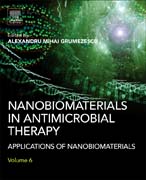
Nanobiomaterials in Antimicrobial Therapy: Applications of Nanobiomaterials
Grumezescu, Alexandru
Nanobiomaterials in Antimicrobial Therapy presents novel antimicrobial approaches that enable nanotechnology to be used effectively in the treatment of infections. This field has gained a large amount of interest over the last decade, in response to the high resistance of pathogens to antibiotics. Leading researchers from around the world discuss the synthesis routes of nanobiomaterials, characterization, and their applications as antimicrobial agents. The books covers various aspects: mechanisms of toxicity for inorganic nanoparticles against bacteria; the development of excellent carriers for the transport of a high variety of antimicrobials; the use of nanomaterials to facilitate both diagnosis and therapeutic approaches against infectious agents; strategies to control biofilms based on enzymes, biosurfactants, or magnetotactic bacteria; bacterial adhesion onto polymeric surfaces and novel materials; and antimicrobial photodynamic inactivation. This book will be of interest to postdoctoral researchers, professors and students engaged in the fields of materials science, biotechnology and applied chemistry. It will also be highly valuable to those working in industry, including pharmaceutics and biotechnology companies, medical researchers, biomedical engineers and advanced clinicians. A methodical approach to this highly relevant subject for researchers, practitioners and students working in biomedical, biotechnological and engineering fields.A valuable guide to recent scientific progress and the latest application methods.Proposes novel opportunities and ideas for developing or improving technologies in nanomedicine and nanobiology. INDICE: Introduction to Nanobiomaterials in Antimicrobial Therapies Chapter 1: Antimicrobial photoinactivation with functionalized fullerenes Chapter 2: Toxicity of inorganic nanoparticles against prokaryotic cells Chapter 3: Antimicrobial magnetosomes for topical antimicrobial therapy Chapter 4: Synthesis, characterization, and applications of nanobiomaterials for antimicrobial therapy Chapter 5: Antimicrobial micro/nanostructured functional polymer surfaces Chapter 6: Differential biological activities of silver nanoparticles against Gram-negative and Gram-positive bacteria: a novel approach for antimicrobial therapy Chapter 7: Enhancement of pathogen detection and therapy with laser-activated, functionalized gold nanoparticles Chapter 8: Antimicrobial properties of nanobiomaterials and the mechanism Chapter 9: Scopes of green synthesized metal and metal oxide nanomaterials in antimicrobial therapy Chapter 10: Antifungal nanomaterials: synthesis, properties, and applications Chapter 11: Strategies based on microbial enzymes and surface-active compounds entrapped in liposomes for bacterial biofilm control Chapter 12: Interaction of nanoceria with microorganisms Chapter 13: PLA and PLGA nanoarchitectonics for improving anti-infective drugs efficiency Chapter 14: Nanoparticles: boon to mankind and bane to pathogens Chapter 15: The citation classics in antimicrobial nanobiomaterials
- ISBN: 978-0-323-42864-4
- Editorial: William Andrew
- Encuadernacion: Cartoné
- Páginas: 400
- Fecha Publicación: 11/04/2016
- Nº Volúmenes: 1
- Idioma: Inglés
- Inicio /
- /
